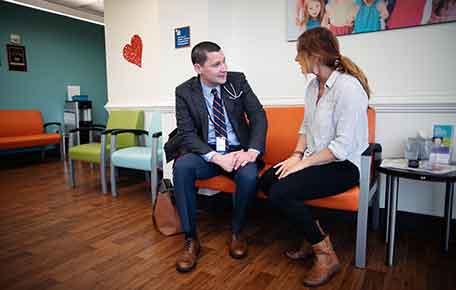Septal Defects Treatment
Make an Appointment
Finding out your baby has a hole in their heart can be overwhelming. Maybe you learned about this heart problem during a routine ultrasound. Or your newborn has a heart murmur. Now you’re faced with a lot of questions and decisions about septal defects. What does this mean for your child? Where should you get treatment? What happens next?
Septal Defects at UVA Health Children's
At UVA Health Children’s, our experienced congenital heart surgeons perform surgery on babies with even the most complex heart conditions. The babies we treat have higher survival and success rates than the national average.
Plus, your baby gets care at UVA Health Children's, named the #1 children's hospital in Virginia by U.S. News & World Report.
See our success rates.
Treatment for a Hole in the Heart
Some holes in a newborn's heart require more expertise than others. At UVA Health Children's, you can trust we have experience in repairing all of these.
Atrioventricular Septal Defect Surgery
At UVA Health Children’s, you'll find surgeons with highly specialized expertise in repairing atrioventricular septal defects (AVSD), also called AV canal defects. When your baby has AV canal, it means their heart has only one valve between their upper and lower heart chambers. Babies are usually born with two valves. They also have holes between their two upper and two lower heart chambers that shouldn’t be there.
This the most complex type of septal defect. Babies born with it need surgery.
When your baby is about 4-6 months old, a complete AVSD repair will:
- Separate the one valve between your baby’s upper and lower heart chambers into two valves, including a tricuspid valve between the two right heart chambers and mitral valve between the two left chambers
- Close the hole in the wall (septum) between their two upper heart chambers (atria), called an atrial septal defect
- Close the hole in the wall between their two lower heart chambers (ventricles), called a ventricular septal defect
After surgery, your baby’s heart will no longer have to work as hard to pump blood to their body. At UVA Children’s, our survival rate for complete AVSD repair is 100%, which is higher than the national average.
Atrial, Ventricular, & Patent Ductus Arteriosus Repair
More common septal defects include:
- Ventricular septal defect, a hole in the wall (septum) between your baby’s two lower heart chambers (ventricles)
- Atrial septal defect, a hole in the wall between your baby’s two upper heart chambers (atria)
- Patent ductus arteriosus (PDA), when the opening between the two major blood vessels leading away from the heart stays open instead of closing after birth
Sometimes, these holes close on their own. Depending on your child’s symptoms, we may treat them with medicine.
If the hole is large and doesn't close on its own, your child may need the hole patched. In some cases, we can use a procedure that doesn't open up the chest. Instead, our interventional cardiologist will insert a tube (catheter) into a blood vessel in your child’s leg and use it to reach their heart and repair the hole. This kind of procedure results in less pain and means shorter recovery time for your infant.
Congenital Heart Defect Care
- Parent Prep GuideFind Out What to Expect
Caring for an infant with a congenital heart defect requires planning. You face tons of decisions. Questions about what to expect at birth, after, and what's next abound. Find out everything you need to know to get ready for what's ahead.
- A Top-Rated NICUVisit The NICU
Every newborn with a heart defect needs immediate care. At UVA Health Children's, you can trust your infant to our safe and secure neonatal intensive care unit, or NICU. We've earned national recognition for our excellence in caring for the tiniest babies.
- Heart Care for LifePreview The Adult Congenital Heart Disease Clinic
When your baby grows up, they'll still need care. You'll want to make sure that the transition is seamless. At UVA Health, your child will move from pediatric to adult care. We'll never miss a beat.


